Effect of Tea Polyphenols on the Melt Grafting of Glycidyl Methacrylate onto Polypropylene
Abstract
:1. Introduction
2. Materials and Methods
2.1. Materials
2.2. Preparation of the PP/DCP/GMA/C Blends with Different Composite Ratios
2.3. Characterizations
3. Results
3.1. Morphology of the PP/DCP/GMA/C Blends
3.2. MFR of the PP/DCP/GMA/C Blends
3.3. Properties of the PP/DCP/GMA/C Blends
3.3.1. Thermal Behavior
3.3.2. Mechanical Property
3.4. Reaction Mechanism
4. Conclusions
Supplementary Materials
Author Contributions
Funding
Institutional Review Board Statement
Informed Consent Statement
Data Availability Statement
Conflicts of Interest
References
- Khalaj, M.J.; Ahmadi, H.; Lesankhosh, R.; Khalaj, G. Study of physical and mechanical properties of polypropylene nanocomposites for food packaging application: Nano-clay modified with iron nanoparticles. Trends Food Sci. Technol. 2016, 51, 41–48. [Google Scholar] [CrossRef]
- Fasihnia, S.H.; Peighambardoust, S.H.; Peighambardoust, S.J.; Oromiehie, A. Development of novel active polypropylene based packaging films containing different concentrations of sorbic acid. Food Packag. Shelf 2018, 18, 87–94. [Google Scholar] [CrossRef]
- Li, D.; Zhang, J.; Xu, W.; Fu, Y. Effect of SiO2/EVA on the mechanical properties, permeability, and residual solvent of polypropylene packaging films. Polym. Compos. 2016, 37, 101–107. [Google Scholar] [CrossRef]
- Al-Oqla, F.M.; Sapuan, S.M.; Ishak, M.R. A decision-making model for selecting the most appropriate natural fiber–Polypropylene-based composites for automotive applications. J. Compos. Mater. 2016, 50, 543–556. [Google Scholar] [CrossRef]
- Maddah, H.A. Polypropylene as a promising plastic: A review. Am. J. Polym. Sci. 2016, 6, 1–11. [Google Scholar]
- Alam, F.E.; Yu, J.; Shen, D.; Dai, W.; Li, H.; Zeng, X.; Lin, C.T. Highly conductive 3D segregated graphene architecture in polypropylene composite with efficient EMI shielding. Polymers 2017, 9, 662. [Google Scholar] [CrossRef] [PubMed] [Green Version]
- Xie, X.M.; Chen, N.H.; Guo, B.H.; Li, S. Study of multi-monomer melt-grafting onto polypropylene in an extruder. Polym. Int. 2000, 49, 1677–1683. [Google Scholar] [CrossRef]
- Zhao, W.; Kundu, C.K.; Li, Z.; Li, X.; Zhang, Z. Flame retardant treatments for polypropylene: Strategies and recent advances. Compos. Part A Appl. Sci. Manuf. 2021, 145, 106382. [Google Scholar] [CrossRef]
- Kotal, M.; Bhowmick, A.K. Polymer nanocomposites from modified clays: Recent advances and challenges. Prog. Polym. Sci. 2015, 51, 127–187. [Google Scholar] [CrossRef] [Green Version]
- Oromiehie, A.; Ebadi-Dehaghani, H.; Mirbagheri, S. Chemical modification of polypropylene by maleic anhydride: Melt grafting, characterization and mechanism. Int. J. Chem. Eng. Appl. 2014, 5, 117. [Google Scholar]
- Liu, Y.; Tian, B.; Liu, X. Preparation of polypropylene blends with the long chain branched behavior through reactive blending induced by pre-irradiation. Radiat. Phys. Chem. 2020, 177, 109188. [Google Scholar] [CrossRef]
- Nosova, N.; Roiter, Y.; Samaryk, V. Polypropylene surface peroxidation with heterofunctional polyperoxides. Macromol. Symp. 2004, 210, 339–348. [Google Scholar] [CrossRef]
- Luo, W.; Liu, X.; Fu, Y. Melt grafting of maleic anhydride onto polypropylene with assistance of α-methylstyrene. Polym. Eng. Sci. 2012, 52, 814–819. [Google Scholar] [CrossRef]
- Ouyang, Y.; Mauri, M.; Pourrahimi, A.M.; Östergren, I.; Lund, A.; Gkourmpis, T.; Müller, C. Recyclable polyethylene insulation via reactive compounding with a maleic anhydride-grafted polypropylene. ACS Appl. Polym. Mater. 2020, 2, 2389–2396. [Google Scholar] [CrossRef]
- Shao, W.; Liu, L.; Wang, Y.; Hua, X.; Zhang, F.; Shi, Y. Crystallization, structure, and properties of polypropylene random copolymer (PPR)/high-density polyethylene/polypropylene grafted maleic anhydride ((HDPE/PP)-g-MAH) blends. J. Polym. Res. 2022, 29, 1–9. [Google Scholar] [CrossRef]
- Chen, L.F.; Wong, B.; Baker, W.E. Melt grafting of glycidyl methacrylate onto polypropylene and reactive compatibilization of rubber toughened polypropylene. Polym. Eng. Sci. 1996, 36, 1594–1607. [Google Scholar] [CrossRef]
- Al-Malaika, S.; Eddiyanto, E. Reactive processing of polymers: Effect of bifunctional and tri-functional comonomers on melt grafting of glycidyl methacrylate onto polypropylene. Polym. Degrad. Stabil. 2010, 95, 353–362. [Google Scholar] [CrossRef]
- Burton, E.L.; Woodhead, M.; Coates, P.; Gough, T. Reactive grafting of glycidyl methacrylate onto polypropylene. J. Appl. Polym. Sci. 2010, 117, 2707–2714. [Google Scholar] [CrossRef]
- Mandal, D.K.; Bhunia, H.; Bajpai, P.K.; Kushwaha, J.P.; Chaudhari, C.V.; Dubey, K.A.; Varshney, L. Optimization of acrylic acid grafting onto polypropylene using response surface methodology and its biodegradability. Radiat. Phys. Chem. 2017, 132, 71–81. [Google Scholar] [CrossRef]
- Xie, L. Enhanced fouling-resistance performance of polypropylene hollow fiber membrane fabricated by ultrasonic-assisted graft polymerization of acrylic acid. Appl. Surf. Sci. 2020, 502, 144098. [Google Scholar]
- Cheng, B.; Jiao, X.; Kang, W. Studies on grafting of acrylic acid onto polypropylene melt-blown nonwovens induced by electron-beam preirradiation. J. Appl. Polym. Sci. 2006, 102, 4971–4977. [Google Scholar] [CrossRef]
- Liu, N.C.; Xie, H.Q.; Baker, W.E. Comparison of the effectiveness of different basic functional groups for the reactive compatibilization of polymer blends. Polymer 1993, 34, 4680–4687. [Google Scholar] [CrossRef]
- Song, X.J.; Hu, J.; Wang, C.C. Synthesis of highly surface functionalized monodispersed poly (St/DVB/GMA) nanospheres with soap-free emulsion polymerization followed by facile “click chemistry” with functionalized alkylthiols. Colloid Surf. A 2011, 380, 250–256. [Google Scholar] [CrossRef]
- Shi, D.; Yang, J.; Yao, Z.; Wang, Y.; Huang, H.; Jing, W.; Costa, G. Functionalization of isotactic polypropylene with maleic anhydride by reactive extrusion: Mechanism of melt grafting. Polymer 2001, 42, 5549–5557. [Google Scholar] [CrossRef]
- Cartier, H.; Hu, G.H. Styrene-assisted melt free radical grafting of glycidyl methacrylate onto polypropylene. J. Polym. Sci. Polym. Chem. 1998, 36, 1053–1063. [Google Scholar] [CrossRef]
- Li, Y.; Xie, X.M.; Guo, B.H. Study on styrene-assisted melt free-radical grafting of maleic anhydride onto polypropylene. Polymer 2001, 42, 3419–3425. [Google Scholar] [CrossRef]
- Soukupová, K.; Sassi, A.; Jeřábek, K. Reinforcing of expanded polymer morphology using peroxy radical initiator. React. Funct. Polym. 2009, 69, 353–357. [Google Scholar] [CrossRef]
- Pilevar, Z.; Bahrami, A.; Beikzadeh, S.; Hosseini, H.; Jafari, S.M. Migration of styrene monomer from polystyrene packaging materials into foods: Characterization and safety evaluation. Trends Food Sci. Technol. 2019, 91, 248–261. [Google Scholar] [CrossRef]
- Liang, J.; Yan, H.; Puligundla, P.; Gao, X.; Zhou, Y.; Wan, X. Applications of chitosan nanoparticles to enhance absorption and bioavailability of tea polyphenols (C): A review. Food Hydrocolloid 2017, 69, 286–292. [Google Scholar] [CrossRef]
- Yan, Z.; Zhong, Y.; Duan, Y.; Chen, Q.; Li, F. Antioxidant mechanism of tea polyphenols (C) and its impact on health benefits. Anim. Nutr. 2020, 6, 115–123. [Google Scholar] [CrossRef]
- Xing, L.; Zhang, H.; Qi, R.; Tsao, R.; Mine, Y. Recent advances in the understanding of the health benefits and molecular mechanisms associated with green tea polyphenols (C). J. Agric. Food Chem. 2019, 67, 1029–1043. [Google Scholar] [CrossRef] [PubMed]
- Khan, N.; Mukhtar, H. Tea polyphenols (C) in promotion of human health. Nutrients 2018, 11, 39. [Google Scholar] [CrossRef] [PubMed] [Green Version]
- Liu, Y.; Liang, X.; Wang, S.; Qin, W.; Zhang, Q. Electrospun antimicrobial polylactic acid/tea polyphenol nanofibers for food-packaging applications. Polymers 2018, 10, 561. [Google Scholar] [CrossRef] [PubMed]
- Kanwar, J.; Taskeen, M.; Mohammad, I.; Huo, C.; Chan, T.H.; Dou, Q.P. Recent advances on tea polyphenols (C). Front. Biosci. (Elite Ed.) 2012, 4, 111. [Google Scholar] [CrossRef] [PubMed]
- Shin, M.; Park, E.; Lee, H. Plant-inspired pyrogallol-containing functional materials. Adv. Funct. Mater. 2019, 29, 1903022. [Google Scholar] [CrossRef]
- Behboodi-Sadabad, F.; Zhang, H.; Trouillet, V. UV-Triggered polymerization, deposition, and patterning of plant phenolic compounds. Adv. Funct. Mater. 2017, 27, 1700127. [Google Scholar] [CrossRef] [Green Version]
- Ren, Y.; Wang, F.Y.; Lan, R.T. Polyphenol-assisted chemical crosslinking: A new strategy to achieve highly crosslinked, antioxidative, and antibacterial ultrahigh-molecular-weight polyethylene for total joint replacement. ACS Biomater. Sci. Eng. 2020, 7, 373–381. [Google Scholar] [CrossRef]
- Othman, N.A.F.; Selambakkannu, S.; Abdullah, T.A.T. Grafting yield determination of glycidyl methacrylate vapor on radiated kenaf fiber via FTIR spectroscopy. Mater. Today Proc. 2020, 29, 207–211. [Google Scholar] [CrossRef]
- Zare, Y.; Garmabi, H. Nonisothermal crystallization and melting behavior of PP/nanoclay/CaCO3 ternary nanocomposite. J. Appl. Polym. Sci. 2012, 124, 1225–1233. [Google Scholar] [CrossRef]
- Zhang, D.; Chen, L.; Cai, J.; Dong, Q.; Din, Z.U.; Hu, Z.Z.; Cheng, S.Y. Starch/tea polyphenols (C) nanofibrous films for food packaging application: From facile construction to enhance mechanical, antioxidant and hydrophobic properties. Food Chem. 2021, 360, 129922. [Google Scholar] [CrossRef]
- Deng, P.; Shi, Y.; Liu, Y.; Liu, Y.; Wang, Q. Solidifying process and flame retardancy of epoxy resin cured with boron-containing phenolic resin. Appl. Surf. Sci. 2018, 427, 894–904. [Google Scholar] [CrossRef]
- Kimura, H.; Matsumoto, A.; Ohtsuka, K. Studies on new type of phenolic resin-Curing reaction of bisphenol-A-based benzoxazine with epoxy resin using latent curing agent and the properties of the cured resin. J. Appl. Polym. Sci. 2008, 109, 1248–1256. [Google Scholar] [CrossRef]


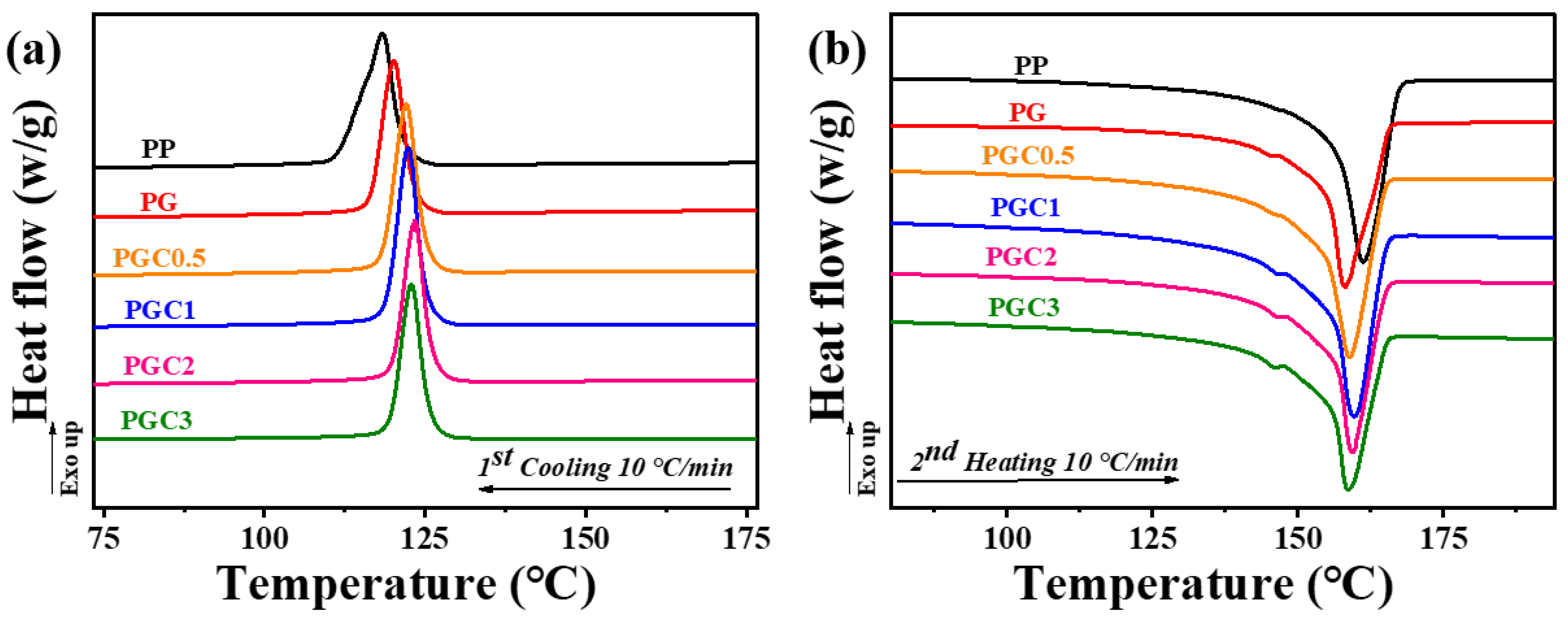
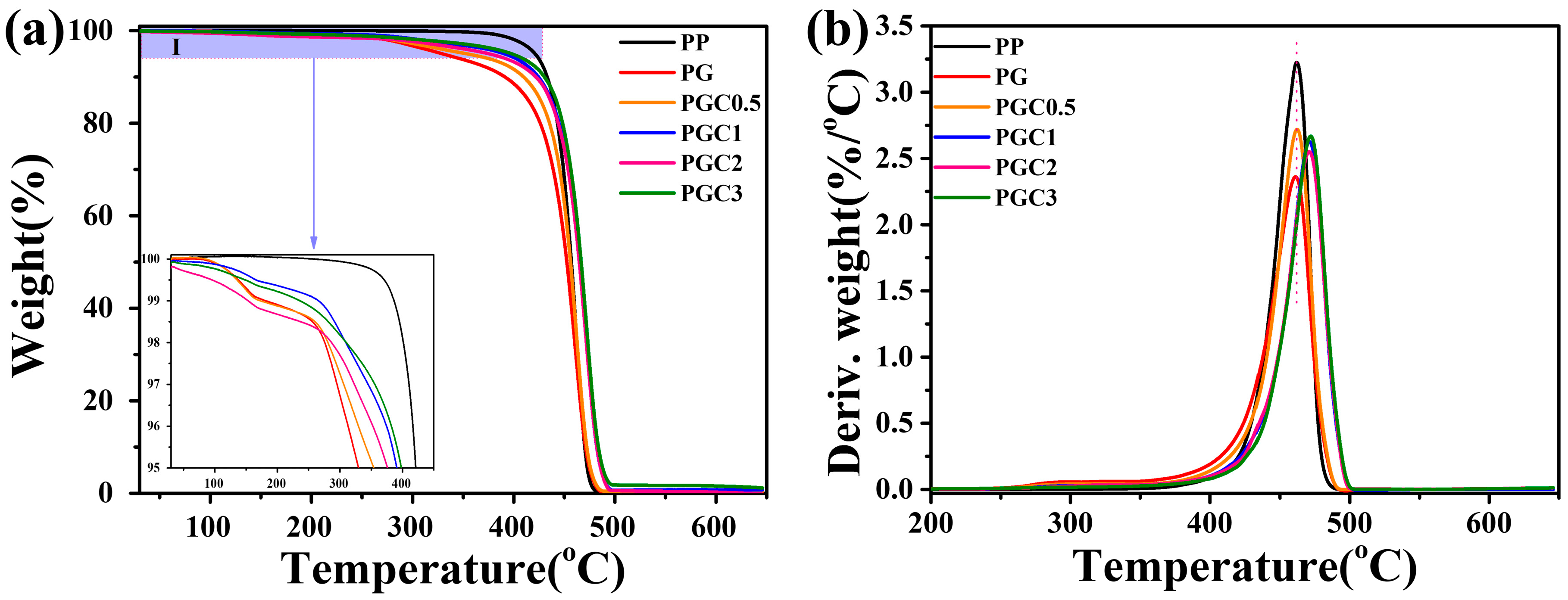
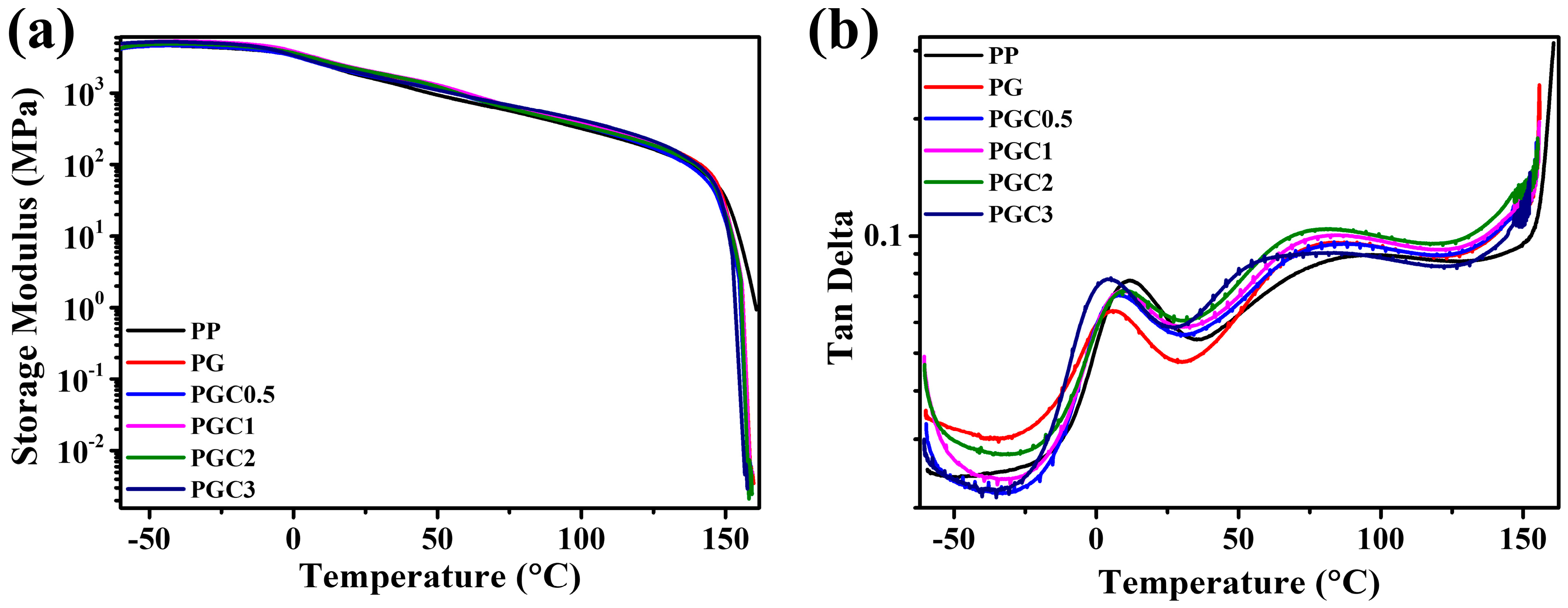
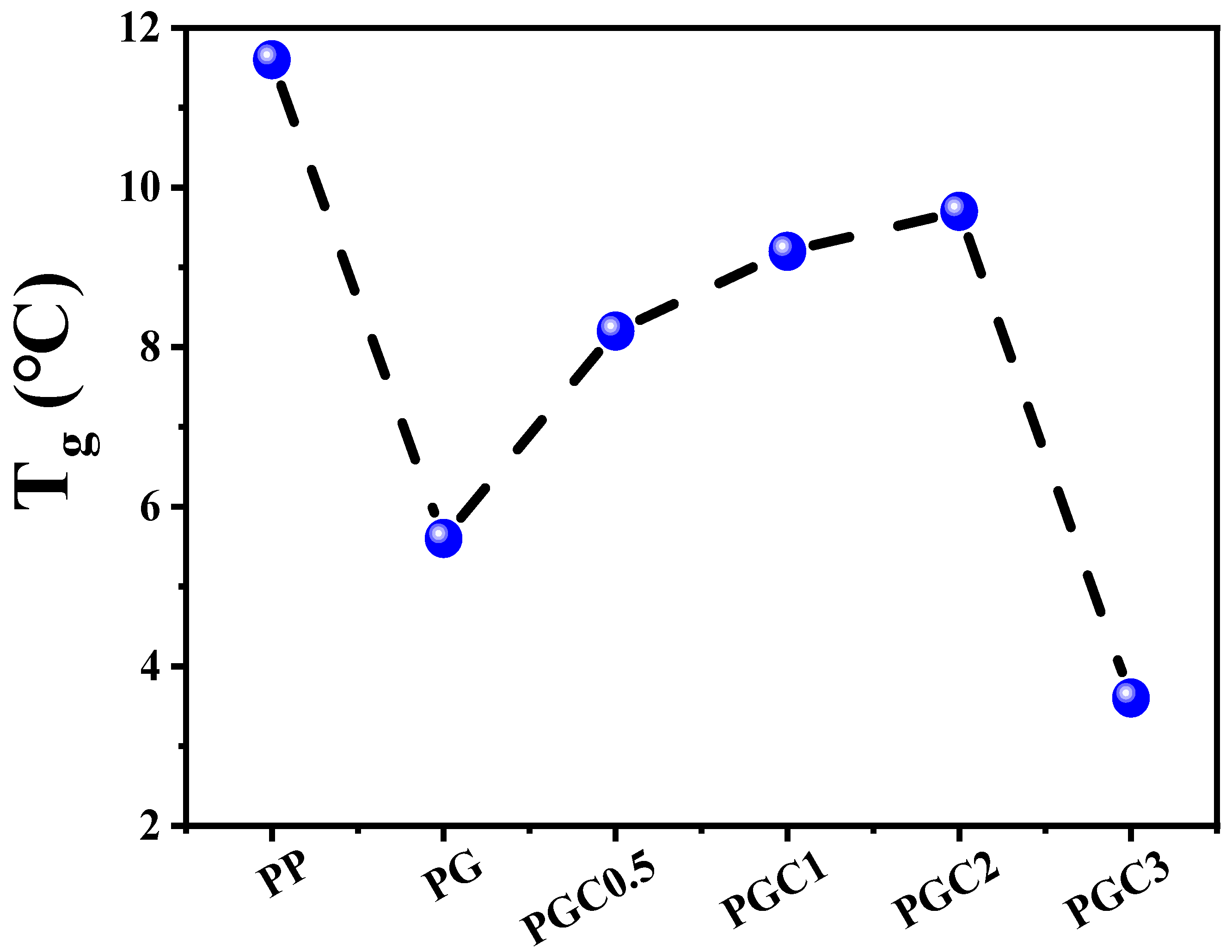
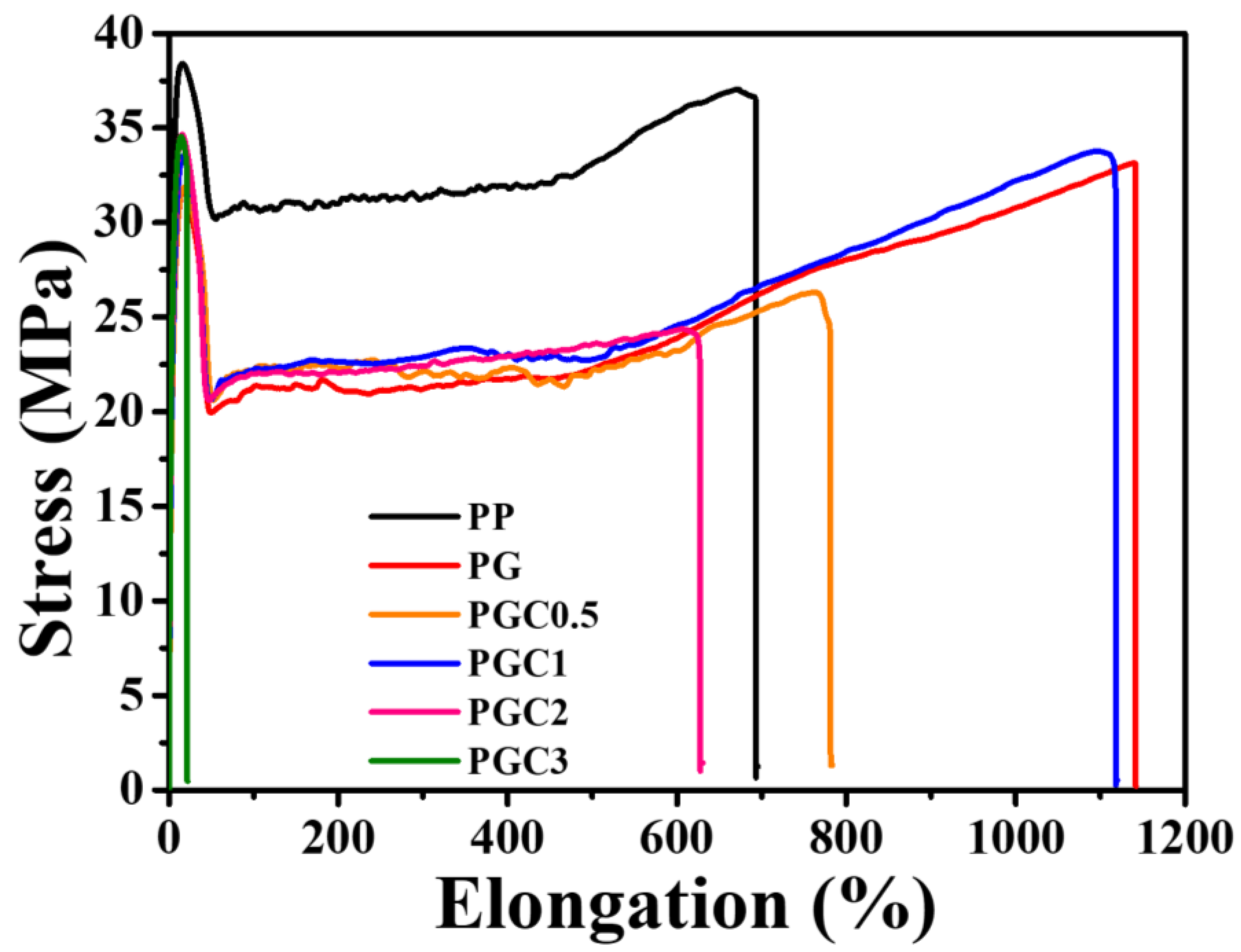
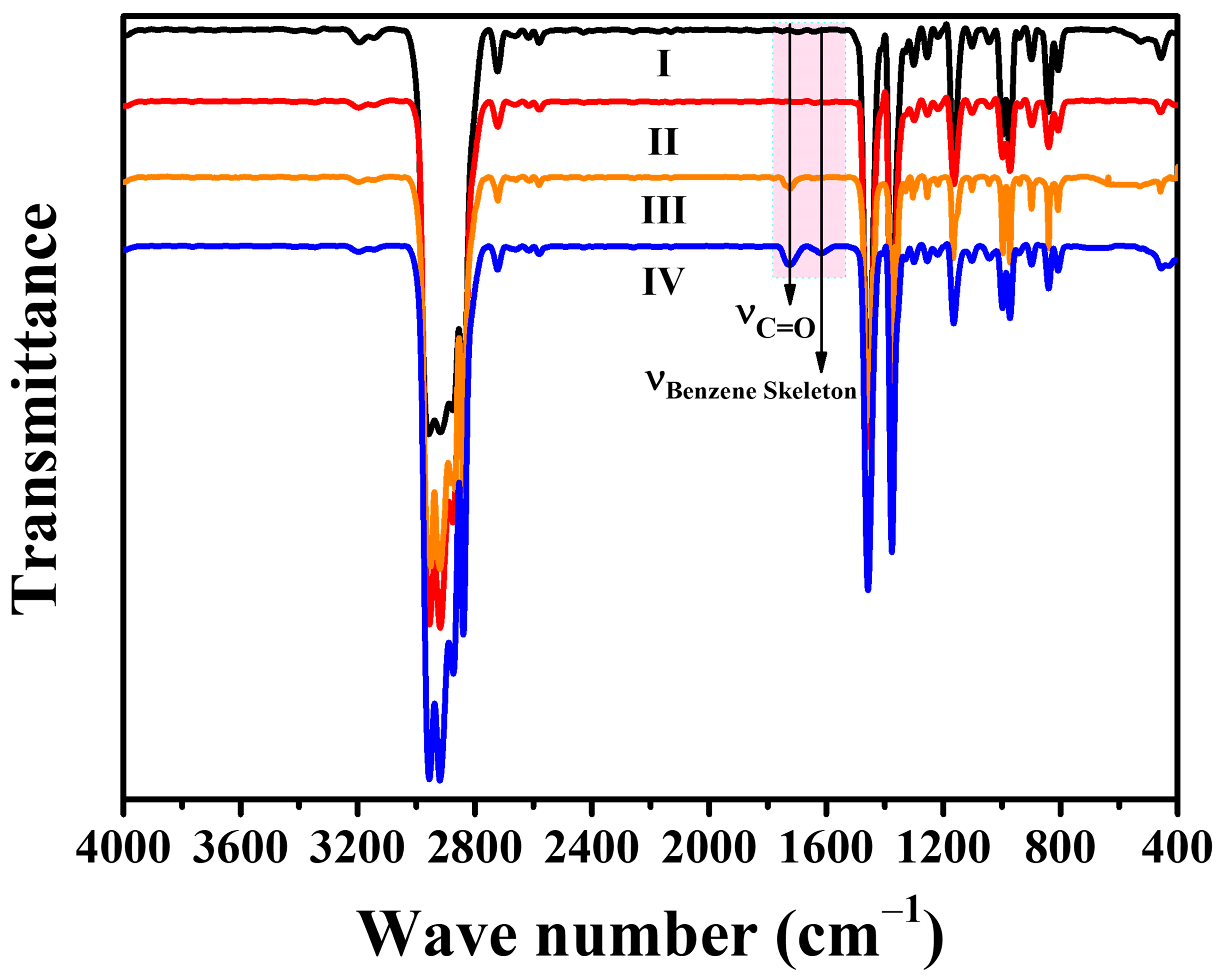
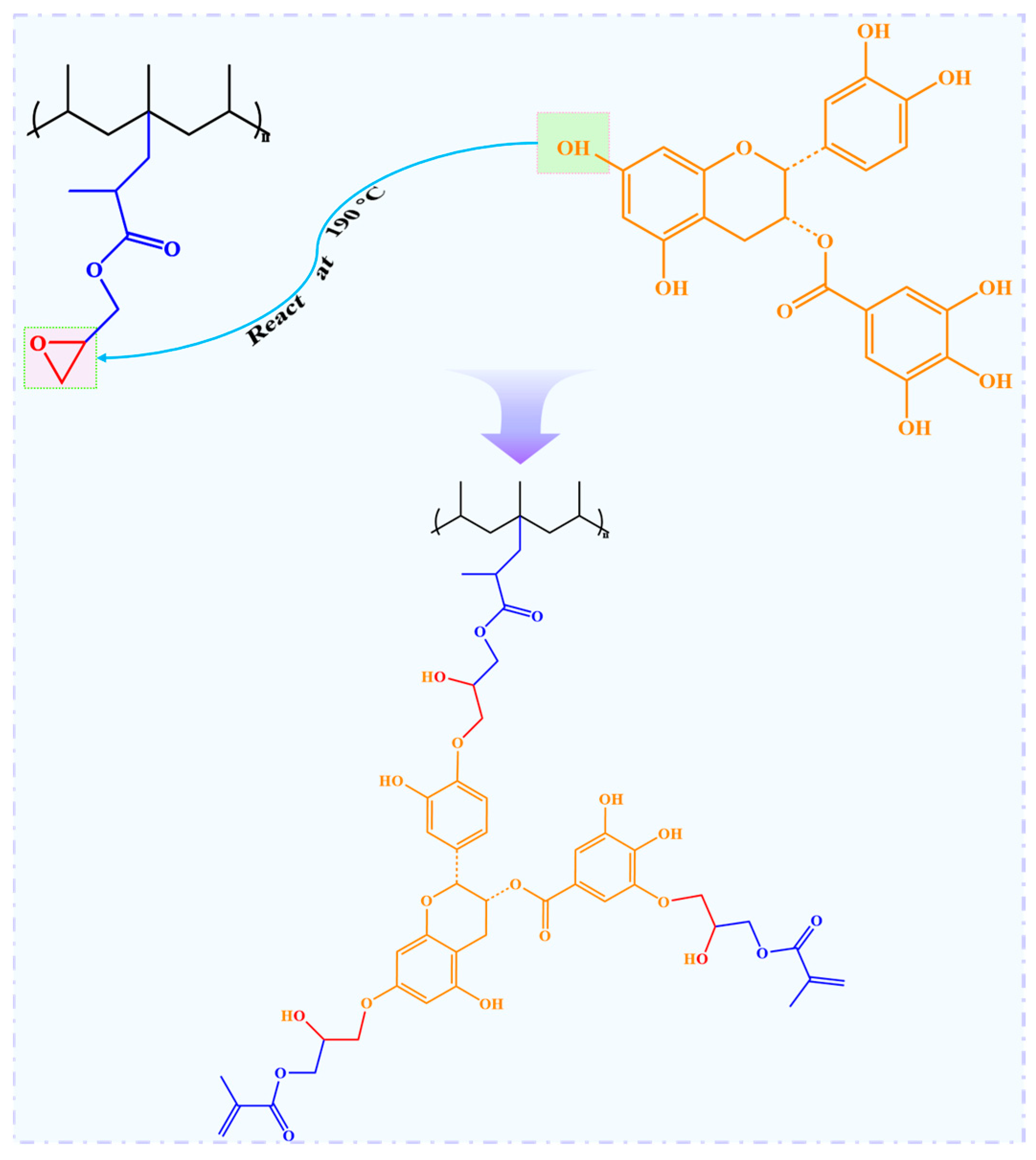
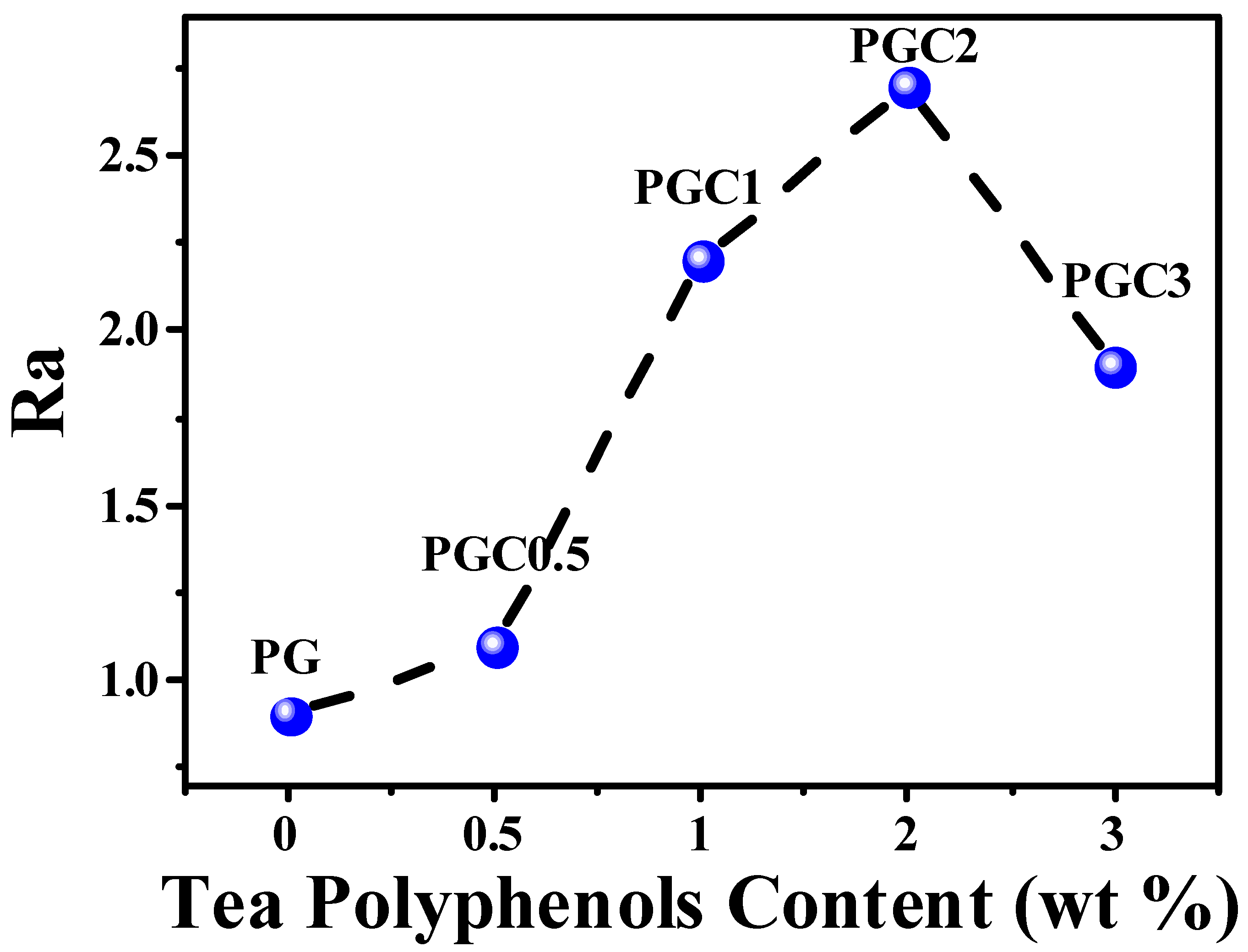
| Sample | PP (wt%) | DCP (wt%) | GMA (wt%) | Tea Polyphenols (C) (wt%) |
|---|---|---|---|---|
| PG | 100 | 0.5 | 5 | 0 |
| PC1 | 100 | 0.5 | 0 | 1 |
| PGC0.5 | 100 | 0.5 | 5 | 0.5 |
| PGC1 | 100 | 0.5 | 5 | 1 |
| PGC2 | 100 | 0.5 | 5 | 2 |
| PGC3 | 100 | 0.5 | 5 | 3 |
| Sample | Tc (°C) | Tm (°C) | Xc (%) | |
|---|---|---|---|---|
| PP | 118.4 | 161.1 | 77.0 | 36.9 |
| PG | 120.2 | 158.2 (145.0) | 78.1 | 39.4 |
| PGC0.5 | 122.1 | 158.9 (145.8) | 82.2 | 41.7 |
| PGC1 | 122.3 | 159.6 (146.2) | 80.6 | 41.1 |
| PGC2 | 123.3 | 159.3 (146.5) | 79.1 | 40.7 |
| PGC3 | 122.9 | 158.5 (145.7) | 81.7 | 42.4 |
| Sample | Yield Strength (MPa) | Young’s Modulus (MPa) | Elongation (%) |
|---|---|---|---|
| PP | 38.6 ± 0.2 | 1173 ± 7 | 693.8 ± 77.4 |
| PG | 32.1 ± 0.4 | 891 ± 28 | 1140.6 ± 65.4 |
| PGC0.5 | 32.7 ± 0.7 | 951 ± 33 | 782.6 ± 102.5 |
| PGC1 | 33.1 ± 0.4 | 933 ± 15 | 1118.0 ± 36.6 |
| PGC2 | 34.0 ± 0.7 | 998 ± 23 | 628.8 ± 37.1 |
| PGC3 | 34.4 ± 0.1 | 1050 ± 4 | 22.1 ± 4.5 |
Publisher’s Note: MDPI stays neutral with regard to jurisdictional claims in published maps and institutional affiliations. |
© 2022 by the authors. Licensee MDPI, Basel, Switzerland. This article is an open access article distributed under the terms and conditions of the Creative Commons Attribution (CC BY) license (https://creativecommons.org/licenses/by/4.0/).
Share and Cite
Zheng, X.; He, L.; Yu, G.; Li, Y. Effect of Tea Polyphenols on the Melt Grafting of Glycidyl Methacrylate onto Polypropylene. Polymers 2022, 14, 5253. https://doi.org/10.3390/polym14235253
Zheng X, He L, Yu G, Li Y. Effect of Tea Polyphenols on the Melt Grafting of Glycidyl Methacrylate onto Polypropylene. Polymers. 2022; 14(23):5253. https://doi.org/10.3390/polym14235253
Chicago/Turabian StyleZheng, Xin, Lina He, Guipeng Yu, and Yongjin Li. 2022. "Effect of Tea Polyphenols on the Melt Grafting of Glycidyl Methacrylate onto Polypropylene" Polymers 14, no. 23: 5253. https://doi.org/10.3390/polym14235253







